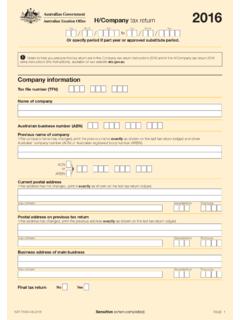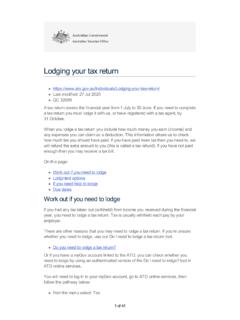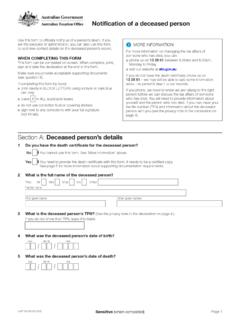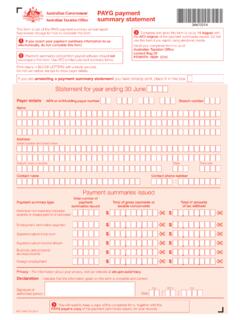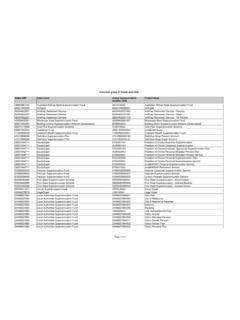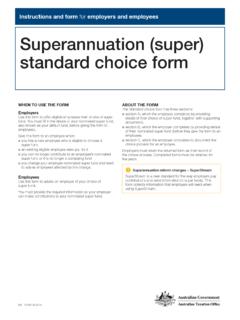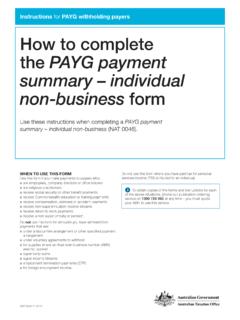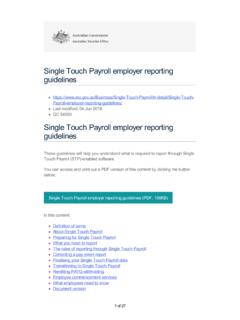Transcription of Back Payments including lump sum payments in arrears
1 Schedule 30 Pay as you go (PAYG) withholding NAT 3348 Back Payments including lump sum Payments in arrearsFOR Payments MADE ON OR AFTER 1 JULY document is a withholding schedule made by the Commissioner of Taxation in accordance with sections 15-25 and 15-30 of Schedule 1 to the Taxation Administration Act 1953. It applies to certain withholding Payments covered by Subdivisions 12-B (except sections 12-50 and 12-55), 12-C (except sections 12-85 and 12-90) and 12-D of Schedule 1 paid as a lump more informationvisit 123/5/08 4:19:56 PM23/5/08 4:19:56 PM2 SCHEDULE 30 BACK Payments including LUMP SUMS IN ARREARSWHO SHOULD USE THIS TABLE?
2 You use this table if you need to work out the amount to withhold from a back payment to a payee on or after 1 July 2008. Back Payments include lump sum Payments in the payment is a bonus or other similar payment, use PAYG withholding tax tables bonuses and similar Payments (NAT 7905).AMOUNT TO BE WITHHELDThe amount to be withheld from a back payment is governed by the information your payee has provided on their Tax file number declaration (NAT 3092). This information only applies to Payments you make after you receive the later declaration provided by a payee overrides an earlier declaration.
3 If you have Employment declarations that were valid at 30 June 2000, they will continue to be valid under TFN PROVIDEDIf your payee has not provided you with their TFN (or claimed an exemption from doing so) you must withhold from their payment at the highest rate, which is for residents and 45% for foreign residents, ignoring any payee who has advised you (through question 1 of their Tax file number declaration) that they have lodged a Tax file number application or enquiry with us has 28 days to give you their TFN. You withhold from a back payment paid during these 28 days in accordance with the instructions in this a payee has not provided you with their TFN by the end of the 28 days, you must withhold at the highest rate (see above) from the total amount of all Payments made to them, unless we tell you not to.
4 This will require you to redo the calculations for the pay periods involved. Do not allow for tax offsets or medicare levy adjustments and do not add amounts for HELP or SFSS to withholding amounts for back Payments , including lump sum Payments in arrears , being made to payees who have not provided you with their TO WORK OUT WITHHOLDING AMOUNTSThe way you work out the amount to withhold depends on whether the payment accrued in: the current financial year, or a prior accrued in the current fi nancial yearTo work out the amount to withhold from a back payment you are paying in the current financial year, you need to work out how much of the back payment accrued in each earlier pay period.
5 You need to determine the amount of withholding that would have been paid in each of those pay periods, then adjust those amounts by the amounts that have already been paid. Method A takes you through the steps A1 Work out how much of the back payment accrued in each earlier pay period. 2 For the first affected pay period, add the back payment relevant to that period to the earnings previously paid to get total earnings for that Use the relevant tax table to find the amount to be withheld from the total earnings for that Subtract the amount previously withheld for the period from the amount worked out in step Repeat steps 2 4 for each pay period affected.
6 Total the amounts calculated in step 4 for each pay Use the relevant tax table to work out the amount to be withheld on the payee s normal earnings for the current pay Work out the total PAYG withholding for this pay period by adding the withholding on the normal pay (the result at step 6) to the withholding on the back payment (the result at step 5). Payments accrued in a prior fi nancial yearThere are two ways to calculate the amount to be withheld from a back payment that accrued in a financial year before the one in which the payment is made, depending on whether the payment was made: less than 12 months after the amount was accrued (use Method B below) more than 12 months after the amount was accrued (use Method C below).
7 Method BUse this method for salary or wages accrued less than 12 months before the date of the back Use the relevant tax table to work out the amount to be withheld on the payee s normal earnings for the current pay Divide the back payment amount by the number of normal pay periods over which it accrued. For example, if a back payment relates to the period August to October and the payee is paid monthly, the number of normal pay periods over which the amount accrued is three. Disregard any cents in the result. (For example, an amount of $ becomes $143.) If the amount is less than $1 this step is nil.
8 In this case there is no amount to be withheld from the back Add the amount worked out at step 2 to the normal payment in the current pay period. This is the combined payment .4 Use the tax table used in step 1 to determine the amount to withhold on the combined payment (see step 3).5 Subtract the amount worked out in step 1 from the amount worked out in step Multiply the amount worked out at step 5 by the number of normal pay periods over which the amount Work out the total PAYG withholding for this pay period by adding the withholding on the normal pay (the result at step 1) to the withholding on the back payment (the result at step 6).
9 223/5/08 4:19:57 PM23/5/08 4:19:57 PMSCHEDULE 30 BACK Payments including LUMP SUMS IN arrears 3 Method CFollow the steps below to work out the amount to be withheld from back Payments of: salary or wages that were accrued more than 12 months before the date of the back payment, and all other amounts that accrued in a prior financial Use the relevant tax table to work out the amount to be withheld on the payee s normal earnings for one pay period in the current financial Divide the back payment by the number of normal pay periods in 12 months (that is, 12 monthly Payments , 26 fortnightly Payments or 52 weekly Payments ).
10 Disregard any cents in the result. (For example, $ becomes $143.) If the amount is less than $1 this step is nil. In this case there is no amount to be withheld from the back Add the amount worked out at step 2 to the normal payment in the current pay period. This is the combined payment .4 Use the tax table used in step 1 to determine the amount to withhold on the combined payment (see step 3).5 Subtract the amount worked out in step 1 from the amount worked out in step Multiply the amount worked out at step 5 by the number of normal pay periods in 12 months (see step 2).7 Work out the total PAYG withholding for this pay period by adding the withholding on the normal pay (the result at step 1) to the withholding on the back payment (the result at step 6).
